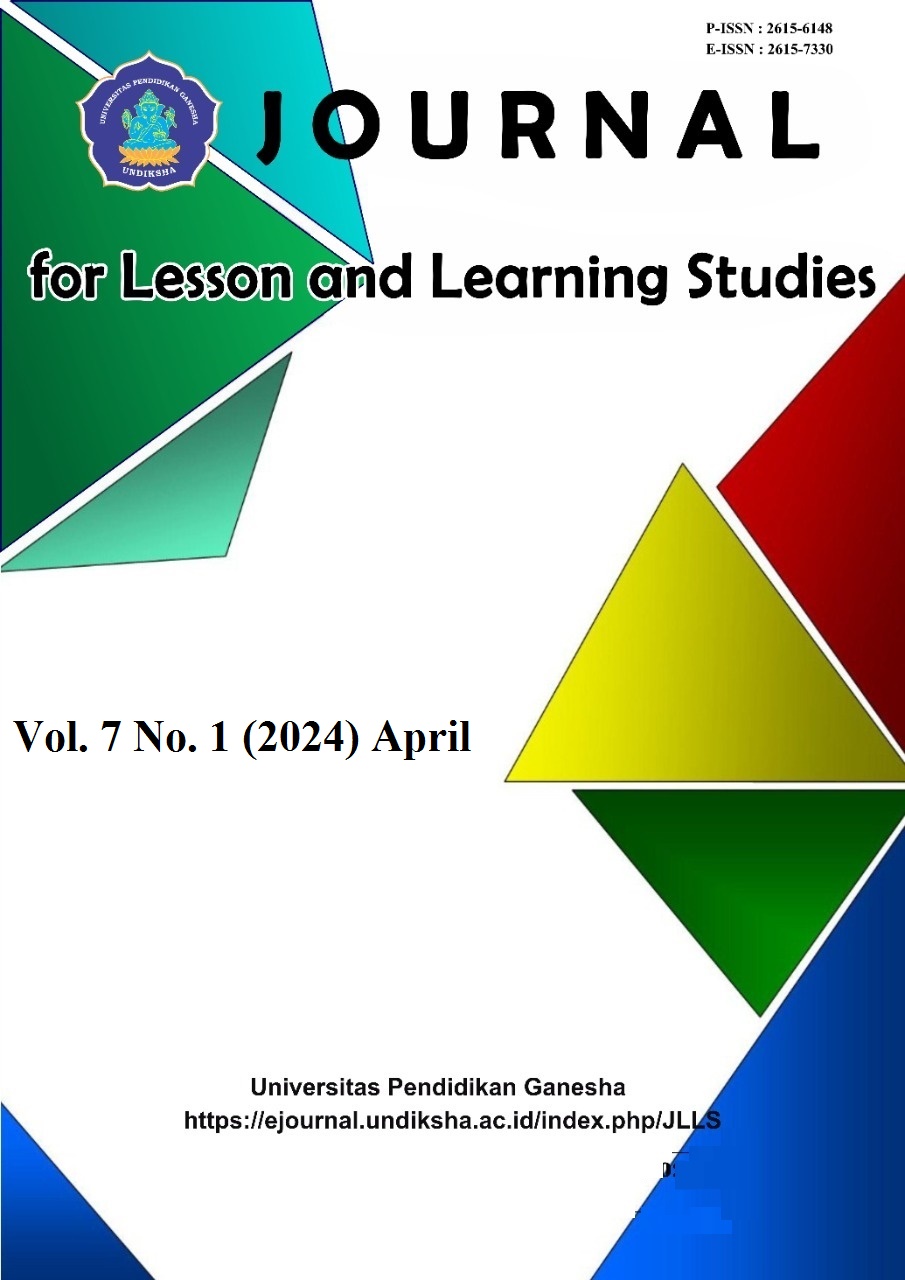GASEKO: Scramble Game Media to Increase Elementary School Students’ Learning Independence
DOI:
https://doi.org/10.23887/jlls.v7i1.74957Keywords:
Media, Game, Scramble, Economic, IndependenceAbstract
The lack of diversity in digital media and the low degree of student learning independence in primary schools prompted this development inquiry. In order to help fourth graders become more self-reliant learners, this study seeks to develop a realistic, practical, and successful economic scramble game (GASEKO) for classroom usage. The goal of this research was to analyze the extent to which fourth grade primary school pupils were able to learn independently, and the subjects’ included students, learning technology experts, and subject matter experts. The five-stage ADDIE model—which is used in this development study—consists of the following steps: analysis, design, development, implementation, and evaluation. A questionnaire or surveys are the tools utilized for gathering information. Fifteen primary school pupils in the fourth grade participated in the product trial. Qualitative, quantitative, and statistical descriptive analytic methods were employed to examine the study data. We can conclude that GASEKO media is a viable, practical, and effective strategy for enhancing the learning independence of fourth graders based on the following evidence: (1) GASEKO media has strong credentials from expert validation; (2) GASEKO media has very good credentials according to student responses; and (3) GASEKO media significantly impacts fourth graders' learning independence. This study's findings suggest that GASEKO media can broaden the range of educational resources available to schools, leading to more engaging and effective lessons for students.
References
Airlanda, P. (2021). Pengembangan Media Animus dalam Pembelajaran IPAS di Sekolah Dasar. Jurnal Basicedu, 5(3), 1683–1688. https://doi.org/https://doi.org/10.31004/basicedu.v6i6.4999. DOI: https://doi.org/10.31004/basicedu.v5i3.1187
Alfiansyah. (2019). Pengembangan Aplikasi Smartphone KJPAI Berbasis Android Menggunakan APPYET untuk Menunjang Sistem Informasi Jurusan Pendidikan Agama Islam. Fakultas Tarbiyah Dan Keguruan Universitas Islam Negeri Raden Intan Lampung, 561(3), 1–98. http://repository.radenintan.ac.id/6883/1/KIKI ALFIANSYAH 1511010291.pdf.
Amalia, I. (2020). Menggunakan Teknologi Informasi Dan Komunikasi (TIK) Dalam Proses Pembelajaran Di Sekolah Dasar. Jurnal Pendidikan Dan Konseling (JPDK), 2(2), 152–155. https://doi.org/10.31004/jpdk.v2i1.900. DOI: https://doi.org/10.31004/jpdk.v2i1.900
Amin, & Hadiwinarto. (2022). Evaluasi Kemandirian Belajar. Jurnal Pendidikan Biologi Dan Sains, 5(1), 1–8. https://doi.org/https://doi.org/10.31539/bioedusains.v5i1.3060 DOI: https://doi.org/10.31539/bioedusains.v5i1.3060
Anggraini, D., Khumaedi, M., & Widowati, T. (2020). Validity and reliability contents of independence assessment instruments of basic beauty students for class X SMK. Journal of Research and Educational Research Evaluation, 9(1), 40–46. https://doi.org/10.15294/jere.v9i1.42558. DOI: https://doi.org/10.15294/jere.v9i1.42558
Ardiansyah, Ruli, & Aini. (2019). Analisis Kemampuan Literasi Matematis Siswa dalam Menyelesaikan Soal PISA Ditinjau dari Kemandirian Belajar. Jurnal Ilmiah Pendidikan Matematika, 1(2), 25–33. https://doi.org/http://dx.doi.org/10.30870/jppm.v16i2.17908. DOI: https://doi.org/10.36815/majamath.v1i1.153
Arista, F. S., & Kuswanto, H. (2018). Virtual physics laboratory application based on the android smartphone to improve learning independence and conceptual understanding. International Journal of Instruction, 11(1), 1–16. https://doi.org/10.12973/iji.2018.1111a. DOI: https://doi.org/10.12973/iji.2018.1111a
Avando Bastari, Adi Bandono, & Okol Sri Suharyo. (2021). The development strategy of smart campus for improving excellent navy human resources. Global Journal of Engineering and Technology Advances, 6(2), 033–043. https://doi.org/10.30574/gjeta.2021.6.2.0011. DOI: https://doi.org/10.30574/gjeta.2021.6.2.0011
Bujuri, D. A. (2018). Analisis perkembangan kognitif anak usia dasar dan implikasinya dalam kegiatan belajar mengajar. LITERASI (Jurnal Ilmu Pendidikan), 9(1), 37–50. https://www.ejournal.almaata.ac.id/index.php/LITERASI/article/view/720. DOI: https://doi.org/10.21927/literasi.2018.9(1).37-50
Cahyana, U., Supatmi, S., Erdawati, & Rahmawati, Y. (2019). The Influence of Web-Based Learning and Learning Independence Toward Student’s Scientific Literacy in Chemistry Course. International Journal of Instruction, 12(4), 655–668. https://doi.org/10.29333/iji.2019.12442a. DOI: https://doi.org/10.29333/iji.2019.12442a
Chen, H., Yang, X., Xia, W., Li, Y., Deng, Y., & Fan, C. (2023). The Relationship Between Gratitude and Job Satisfaction: The Mediating Roles of Social Support and Job Crafting. Curr Psychol, 42, 3134–3141. https://doi.org/10.1007/s12144-021-01658-y DOI: https://doi.org/10.1007/s12144-021-01658-y
Elmahdi, I., Al-Hattami, A., & Fawzi, H. (2018). Using Technology for Formative Assessment to Improve Students’ Learning. Turkish Online Journal of Educational Technology-TOJET, 17(2), 182–188. https://eric.ed.gov/?id=EJ1176157.
Fajriyah, L., Nugraha, Y., Akbar, P., & Bernard, M. (2019). Pengaruh Kemandirian Belajar Siswa SMP Terhadap Kemampuan Penalaran Matematis. Journal On Education, 01(02), 288–296. https://doi.org/10.31004/joe.v1i2.66.
Febriani, V. (2016). Pengaruh Efikasi Diri dan Regulasi Diri Terhadap Kemandirian Belajar Siswa pada. Jurnal Pendidikan Guru Sekolah Dasar, 5(24), 355–364. https://journal.student.uny.ac.id/index.php/pgsd/article/view/4204.
Febriyanto. (2018). Scramble Game dalam Pembelajaran Writing di Kelas V Sekolah Dasar. Jurnal Cakrawala Pendas, 4(1), 75–86. https://doi.org/10.31949/jcp.v4i1.764 DOI: https://doi.org/10.31949/jcp.v4i1.764
Fitriana, I., Martati, B., & Naila, I. (2021). Analisis Kemandirian Belajar Siswa Sekolah Dasar di Surabaya. Jurnal Pendidikan Tambusai, 5(1), 9946–9950. https://doi.org/10.31004/jptam.v5i3.2560
Harahap, I. A., & Yarshal, D. (2023). Development of Digital Learning Media Helped Capcut on Theme Care Against Living Things in Class IV SD. International Journal of Educational Research Excellence, 2(2), 166–172. https://doi.org/10.55299/ serve.v 2i2.456. DOI: https://doi.org/10.55299/ijere.v2i2.456
Hartini, H., Danial, D., & Munawaroh, M. (2021). Pengaruh Sarana Pembelajaran dan Motivasi Belajar Matematika Terhadap Kemandirian Belajar Peserta Didik Kelas VII SMP Negeri 2 Kotabaru. JTMT: Journal Tadris Matematika, 2(2), 40–48. https://doi.org/10.47435/jtmt.v2i2.749. DOI: https://doi.org/10.47435/jtmt.v2i2.749
Hidayat, F., & Nizar, M. (2021). Model Addie (Analysis, Design, Development, Implementation and Evaluation) Dalam Pembelajaran Pendidikan Agama Islam. Jurnal Inovasi Pendidikan Agama Islam (JIPAI, 1(1), 28– 38. https://doi.org/10.15575/jipai.v1i1.11042. DOI: https://doi.org/10.15575/jipai.v1i1.11042
Jamalin, N. P., & Hartoyo, I. (2021). Developing Scramble Game Using Classdojo As Students’ Media In Reading Descriptive Text For The Seventh Grade Students of SMP Dharma Pancasila Medan. REGISTER: Journal of English Language Teaching of FBS-Unimed, 10(3), 1–11. https://doi.org/10.24114/reg.v10i3.29972. DOI: https://doi.org/10.24114/reg.v10i3.29972
Karima, M. K., & Ramadhani. (2018). Permasalahan Pembelajaran IPS dan Strategi Jitu Pemecahannya. Ittihad: Jurnal Pendidikan, 2(1), 43–53. http://repository.uinsu.ac.id/5718/.
Kong, K., & Yong, E. S. (2022). Effect of Problem Behaviors on Early Literacy Skills: A Malaysian Experience. Early Childhood Education Journal, 1–8. https://doi.org/10.1007/s10643-022-01337-y. DOI: https://doi.org/10.1007/s10643-022-01337-y
Lampropoulos, G., Siakas, K., & Anastasiadis, T. (2019). Internet of Things in the Context of Industry 4.0: An Overview. International Journal of Entrepreneurial Knowledge, 7(1), 4–19. https://doi.org/10.2478/ijek-2019-0001. DOI: https://doi.org/10.2478/ijek-2019-0001
Lestari, N. A. P., Wati, N. N. K., Sudiana, I. N., & Putrayasa, I. B. (2023). Pengembangan Lembar Kerja Siswa Berorientasi Keterampilan Proses Dalam Meningkatkan Kemandirian Belajar Siswa Sd Pada Mata Pelajaran Bahasa Indonesia. Jurnal Ilmiah Pendidikan Citra Bakti, 10(2). https://doi.org/10.38048/jipcb.v10i2.1264. DOI: https://doi.org/10.38048/jipcb.v10i2.1264
Mohammed, A. O., & Pitan, O. S. (2018). Innovation and Renewal of Economics Curriculum in Nigerian Secondary Schools: Approaches, Problems, and Strategies. Journal of Economics and Environmental Education, 3(1), 10–20. https://www.researchgate.net/profile/Abidat-Mohammed/publication/364957777.
Morrar, R., Arman, H., & Mousa, S. (2017). The fourth industrial revolution (Industry 4.0): A social innovation perspective. Technology Innovation Management Review, 7(11), 12–20. https://timreview.ca/sites/default/files/Issue_PDF/TIMReview_November2017.pdf#page=12. DOI: https://doi.org/10.22215/timreview/1117
Nasution, A. S., & Firmansyah, F. (2022). Efektivitas Model Pembelajaran Blended Learning Untuk Meningkatkan Kemampuan Pemecahan Masalah Berbasis Pisa dan Kemandirian Belajar Siswa Mts. Al-jamiyatul Washliyah Tanjung Morawa. Jurnal Math Education Nusantara, 5(2), 65. https://doi.org/10.54314/jmn.v5i2.246. DOI: https://doi.org/10.54314/jmn.v5i2.246
Nurdyansyah, Fahyuni, & Fariyatul. (2021). Characteristics Of Children Age Of Basic Education. Jurnal Penelitian Pendidikan Guru Sekolah Dasar, 3(1), 114–131. https://doi.org/https://doi.org/10.22373/fitrah.v3i1.1330. DOI: https://doi.org/10.22373/fitrah.v3i1.1330
Nurhayati. (2022). Strengthening Pancasila Student Profiles In Independent Learning Curriculum In Elementary School. Lnternational Journal of Humanities and Social Science (IJHESS), 1(6), 976–988. https://doi.org/10.55227/ijhess.v1i6.183. DOI: https://doi.org/10.55227/ijhess.v1i6.183
Ramadhani. (2018). Efektifitas Media Pembelajaran Sentence Scramble Game Terhadap Pemahaman Sintaksis Siswa Tunarungu. Jurnal Widia Ortodidaktika, 7(4), 354–364. https://journal.student.uny.ac.id/index.php/plb/article/view/12172.
Riyadli, H. (2023). Pengembangan Word Scramble Puzzle untuk Edukasi Pengenalan Lagu Nasional pada Anak Usia Dini. Jurnal Sains Komputer Dan Teknologi Informasi, 51(2), 16–18. https://doi.org/10.33084/jsakti.v5i2.4993. DOI: https://doi.org/10.33084/jsakti.v5i2.4993
Sela, Oktavia, & Ayurachmawati. (2023). Pengembangan Media Permainan Monopoli pada Pembelajaran IPS Materi Kebudayaan Indonesia Kelas IV SD. Jurnal Pendidikan Dasar Flobamorata, 4(2), 507–519. https://doi.org/10.51494/jpdf.v4i2.1026. DOI: https://doi.org/10.51494/jpdf.v4i2.1026
Septiana, A. N. I. M. A. W. (2023). Analisis Kritis Materi Ips Dalam Pembelajaran Ipas Kurikulum Merdeka Di Sekolah Dasar. Ilmiah Pendidikan Guru Sekolah Dasar, 1(1). https://stahnmpukuturan.ac.id/jurnal/index.php/pgsd/article/view/3479.
Syalsadilla, Aryaningrum, & Hetilaniar. (2024). Pengembangan Media PAPIN (Papan Pintar) Kegimi (Kegiatan Ekonomi) Pada Mata Pelajaran IPS Kelas 4 SD Negeri 142 Palembang. Jurnal Pendidikan Sosial Dan Konseling, 1(4), 1182–1195. https://jurnal.ittc.web.id/index.php/jpdsk/article/view/565.
Triwahyuningtyas, D., Mahmuda, N. E., & Ardila, A. (2022). E-module of cube and cuboid based on ethnomathematics for five-grade elementary school students. JTAM: Jurnal Teori Dan Aplikasi Matematika, 6(3), 544. https://doi.org/10.31764/jtam.v6i3.8434. DOI: https://doi.org/10.31764/jtam.v6i3.8434
Usman, H., Irfan, M., & Wahyuni, S. (2023). Pengaruh Pemberian Reinforcement Terhadap Kemandirian Belajar Siswa Kelas IV SD 117 Inpres Kurusumange Kecamatan Tanralili Kabupaten Maros. Global Journal Basic Education, 2(2), 92–98. http://www.jurnal.sainsglobal.com/index.php/gjp/article/view/602.
Wardani, L. M. I., Sekarini, D. A., Syaputra, R. D., Kartikawati, M. S., Dawanti, R., Mulia, D. D. A., & Malek, M. D. A. (2021). Career of horizontal education mismatch workers: Career competency, job crafting, and work engagement. Journal of Education and Learning (EduLearn), 15(3), 414–424. https://doi.org/10.11591/edulearn.v15i3.19866. DOI: https://doi.org/10.11591/edulearn.v15i3.19866
Widodo, L. S., Prayitno, H. J., & Widyasari, C. (2021). Kemandirian Belajar Matematika Siswa Sekolah Dasar melalui Daring dengan Model Pembelajaran Flipped Classroom. Jurnal Basicedu, 5(5), 4120–4126. https://doi.org/10.31004/basicedu.v5i5.1404. DOI: https://doi.org/10.31004/basicedu.v5i5.1404
Wiweka, I. N. A., Mahadewi, L. P. P., & Suwatra, I. I. W. (2021). Meningkatkan Hasil Belajar Bahasa Bali Siswa Melalui Multimedia Flashcard Bilingual. Jurnal Edutech Undiksha, 8(1), 95–103. https://doi.org/10.23887/jeu.v9i1.32074. DOI: https://doi.org/10.23887/jeu.v9i1.32074
Wulandari, D. A., Saefuddin, S., & Muzakki, J. A. (2018). Implementasi Pendekatan Metode Montessori Dalam Membentuk Karakter Mandiri Pada Anak Usia Dini. AWLADY : Jurnal Pendidikan Anak, 4(2), 1. https://doi.org/10.24235/awlady.v4i2.3216. DOI: https://doi.org/10.24235/awlady.v4i2.3216
Yuan, Y. (2022). Quantitative analysis of Chinese classroom teaching activity under the background of artificial intelligence. Education and Information Technologies, 27(8), 11161–11177. https://doi.org/10.1007/s10639-022-11080-x. DOI: https://doi.org/10.1007/s10639-022-11080-x
Zahro, Amalia, & Sugito. (2021). Deskripsi Kemandirian Siswa dalam Pembelajaran Daring Pada Masa Pandemi Covid. Attanwir : Jurnal Keislaman Dan Pendidikan, 12(1), 63–75. https://doi.org/10.53915/jurnalkeislamandanpendidikan.v12i1.50. DOI: https://doi.org/10.53915/jurnalkeislamandanpendidikan.v12i1.50
Zurhaida, Z., Nurfitria, S., & Nur Aeni, A. (2022). Pengembangan Words Scramble Game Tentang Politik Islam Sebagai Media Pembelajaran Siswa Kelas V SD. Jurnal Pendidikan Dan Teknologi Indonesia, 2(6), 273–278. https://doi.org/10.52436/1.jpti.181. DOI: https://doi.org/10.52436/1.jpti.181
Downloads
Published
How to Cite
Issue
Section
License
Copyright (c) 2024 Ni Kadek Eka Budi Darmayanti, I Made Suarjana

This work is licensed under a Creative Commons Attribution-ShareAlike 4.0 International License.
Authors who publish with the Journal for Lesson and Learning Studies agree to the following terms:
- Authors retain copyright and grant the journal the right of first publication with the work simultaneously licensed under a Creative Commons Attribution License (CC BY-SA 4.0) that allows others to share the work with an acknowledgment of the work's authorship and initial publication in this journal.
- Authors are able to enter into separate, additional contractual arrangements for the non-exclusive distribution of the journal's published version of the work (e.g., post it to an institutional repository or publish it in a book), with an acknowledgment of its initial publication in this journal.
- Authors are permitted and encouraged to post their work online (e.g., in institutional repositories or on their website) prior to and during the submission process, as it can lead to productive exchanges, as well as earlier and greater citation of published work. (See The Effect of Open Access)




